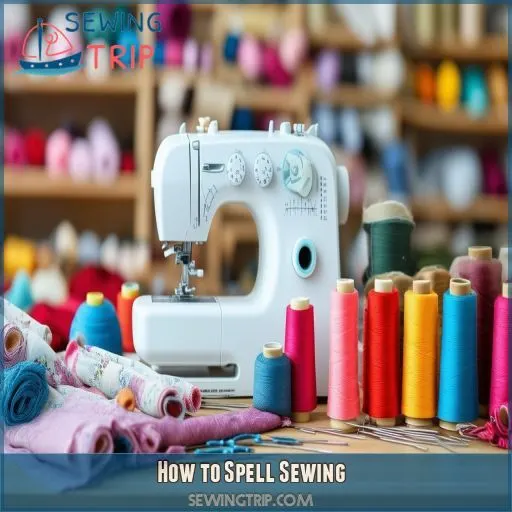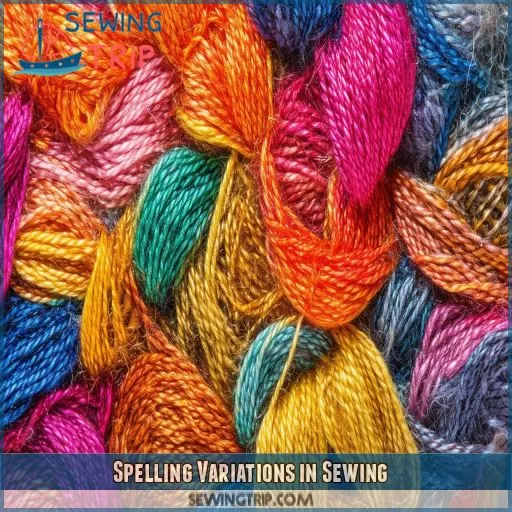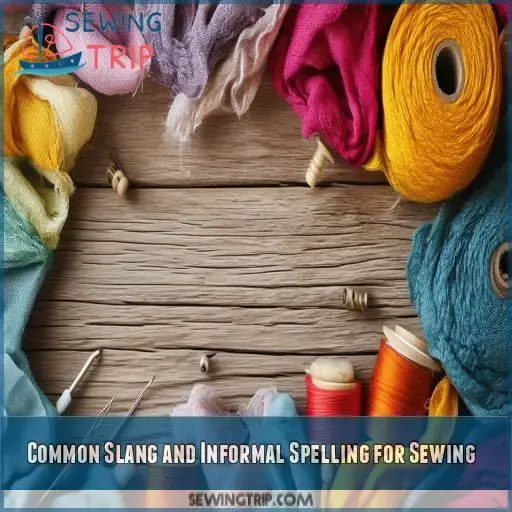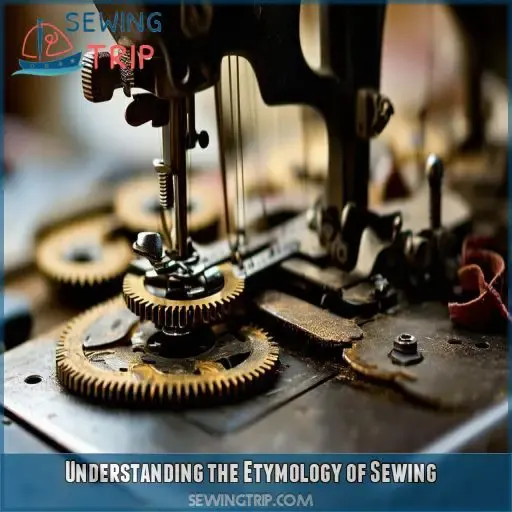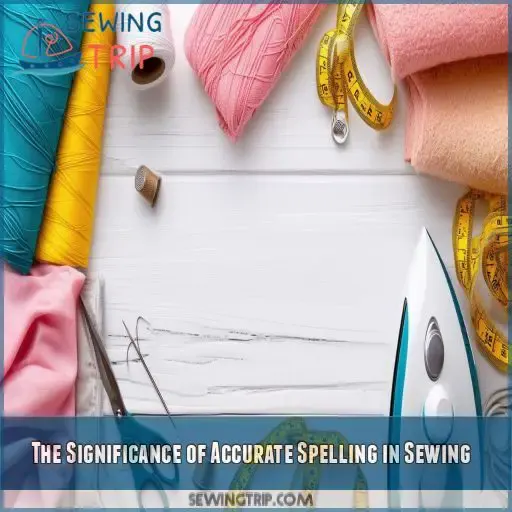This site is supported by our readers. We may earn a commission, at no cost to you, if you purchase through links.
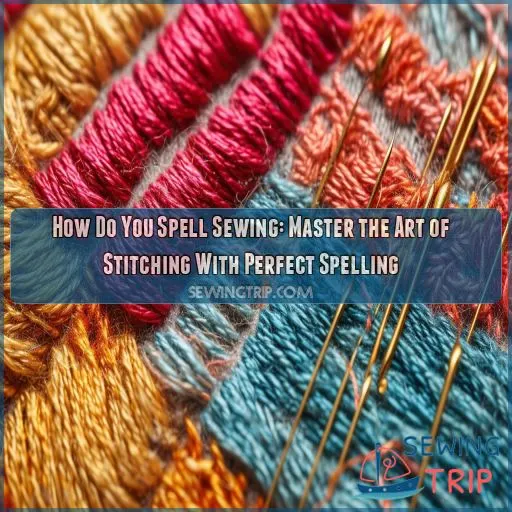
Most people get confused because of misspellings, which you could actually avoid if things were to be explained.
This guide explores how to spell sewing correctly, delves into its etymology, and puts emphasis on the importance of proper spelling.
Whether you are starting out as a tailor or have years of experience, proper spelling gives professional communication and improves the sewing skills overall.
Dive in to perfect your craft.
Table Of Contents
Key Takeaways
- Spelling "sewing" correctly is crucial to avoid costly mistakes, as even a slight misspelling can lead to confusion and miscommunication.
- Knowing the etymology of "sewing" can deepen your appreciation for the craft, as it showcases the universality of sewing skills across cultures and time.
- Mastering the correct spelling of "sewing" empowers you to communicate professionally, ensuring clear instructions and seamless collaboration with fellow crafters.
- Don’t let a simple word like "sewing" trip you up. Embrace the learning curve, and watch your sewing skills soar as you become a confident and precise communicator in the world of stitchery.
How Do You Spell Sewing?
To spell "sewing" correctly, you’ll want to combine the Old English root "sew" with the "-ing" suffix. It’s a straightforward spelling that’s easy to remember – just think of "sew" plus "ing" equals "sewing."
While you may come across regional variations like "sowing" or archaic forms like "seuing," the standard spelling is "sewing." Mastering this simple spelling will help you navigate the sewing world with confidence, from reading patterns to communicating with fellow crafters.
And if you’re curious to dive deeper into the fascinating history and nuances of this essential skill, keep reading.
How to Spell Sewing
Where one wants to start, if one is to truly master the art of stitching, with the very basics: how to spell "sewing" properly. It’s a very basic word, but one that has often tripped up even the seasoned crafters. Let’s break it down: S-E-W-I-N-G. The root word "sew" has an interesting etymology that goes all the way back to Old English "siwian," further still to Proto-Indo-European roots.
Let’s forget, lest we get confused, that "sew" is a homophone of "so" and "sow," yet they’re broadly different from one another—like a sewing tool compared with a farm tool. Along with this regional variation comes differences in the way these words are pronounced, but their spelling remains the same everywhere in the English-speaking world.
Spelling rules can help: think "ew" as in "few," then add "-ing." It’s a stitch in time, which saves nine in terms of proper writing. By hammering out that one basic element, you have strung the thread of language precision into your crafting journey.
Spelling Variations in Sewing
Now that you have learned to spell "sewing" properly, let’s talk about some variations you may come across. While "sewing" is the standard spelling, regional differences and common misspellings will sometimes slip through and catch the seasoned stitcher unawares.
Within the basics of sewing will be these variations:
– "Sowing": Often misused because of the close pronunciation
- "Soeing": A phonetic misspelling some beginners make
• "Seuing": This is an archaic form, used only in some historical contexts.
One should be aware of such differences in meanings in both home sewing and machine sewing. To perfect spelling and also avoid confusing terms, practice writing "sewing" repeatedly, but at the same time, get familiar with all its homophones. Remember: the word "sew" may be used differently in such contexts as stitching clothes or grounding a ship.
As you become more involved in textile mending and hand sewing, you’ll realize how important clear communication is. This will help you in your sewing instructions and patterns to avoid miscommunication with fellow crafters.
Common Slang and Informal Spelling for Sewing
You’ll notice that, in their craft, sewing enthusiasts often use slang and colloquial spellings. While it’s imperative to get the proper spelling for "sewing" in formal situations, knowing these colloquialisms will help you navigate the communities indefinitely. Here’s a quick guide covering most of the jargon and abbreviations commonly used in sewing:
| Term | Meaning | Example Usage |
|---|---|---|
| Sewist | Sewer/Sewing Artist | "I’m a passionate sewist" |
| UFO | Unfinished Object | "I have too many UFOs" |
| TNT | Tried ‘n’ True Pattern | "This is my TNT dress" |
Understanding the Etymology of Sewing
Now that we’ve seen a couple of casual spellings, let’s consider the etymology of "sewing." You might be surprised to learn just how ancient this word is. The verb "to sew" is attested to before 900 AD, derived from Middle English "seuen" or "souen." It’s related to Old English "siw [i]an" or "siowan," which is also related to Old Norse, Gothic, and even Sanskrit.
Knowing the etymological journey of "sew" can make one, as a costume designer or makeup artist, appreciate the craft all the more. The word’s evolution reflects just how important sewing skills have been across cultures and time. When stitching a garment, you’re engaged in something that began millennia ago; it’s an intriguing thought.
The etymology of "sew" also enriches its connection with other Indo-European languages, showing just why this important skill has been woven throughout human history. The linguistic lineage underlines the universal nature of sewing across cultures.
The Significance of Accurate Spelling in Sewing
Now that you know a little etymology behind the term "sewing," let’s discuss why spelling is very important in this craft. Whichever may be the case—that you attend sewing camp or work independently—precision in spelling is required. This isn’t for showing one’s prowess to others but because it deals with how well one can communicate and avoid creating costly mistakes.
Herewith are three reasons correct spelling is important in sewing:
- Pattern reading: Spelling mistakes in the instructions may lead to a garment disaster.
- Equipment identification: If you misinterpret "hem weights" as "him waits", your tools won’t be beside you.
- Fabric selection: Mix up the words "silk" and "slick," and you’ll have a very different texture for your project than what you may have wanted.
Frequently Asked Questions (FAQs)
How do you spell "sew like sewing"?
Ah, the fine art of sewing—wherein dexterity and a keen eye conjure into existence wonders. Weave this tapestry with each "sew," careful that every stitch speaks to your expertise.
What is correct spelling of sewing?
The correct spelling is "sewing." It refers to the act of stitching fabrics together with a needle and thread. Remember, "sewing" aligns with creativity and innovation, enhancing your skills with every stitch.
What is the word for sewing something?
Imagine stitching a masterpiece, thread by thread. The word you’re looking for is "sew." It’s the verb used for joining fabric or materials with stitches, typically with a needle and thread or a sewing machine.
What is the adjective of sewing?
The adjective form of "sewing" is "sewing", as in a "sewing basket" or "sewing machine". This modifier describes something related to the act or work of sewing.
What tools are essential in a basic sewing kit?
Think of a sewing kit as a treasure chest. Essential tools include needles, thread, scissors, pins, a measuring tape, a seam ripper, and a thimble. These basics will have you stitching with confidence in no time.
How can you learn basic sewing techniques?
Start by watching online tutorials, practicing hand stitches, and using a basic sewing kit. Join a sewing class or club, read sewing books, and work on simple projects to gradually improve your skills and confidence.
What are some common types of fabric used in sewing?
Did you know that 90% of sewing enthusiasts prefer cotton fabric? Common fabrics you’ll use include cotton, polyester, silk, wool, and linen. Each has unique properties, making them suitable for different projects.
How do you maintain a sewing machine?
In regard to the sewing machine’s maintenance, it’s important to have it regularly cleaned, with an emphasis on the bobbin area. A nylon brush will be ideal for cleaning. Also, avoid spraying canned air into your sewing machine. Do occasional oiling using only sewing machine oil. Annual professional servicing may also be advised for optimum performance [/eo].
What are some popular sewing projects for beginners?
Getting your feet wet with sewing? Try making simple projects like pillowcases, tote bags, or scrunchies. These projects build foundational skills, offer quick satisfaction, and prepare you for more complex creations down the line.
Conclusion
It’s ironic that the easiest words are often the toughest to master.
In sewing, however, the very last concept one should learn is how to spell "sewing" correctly.
Understanding etymology or even the value of standard spelling in enhancing professionalism will help you as a sewer to improve your craft and communicate professionally on matters related to the same.
Don’t let a mere four letters stand in your way, and learn how to spell sewing correctly and watch your craft grow.

